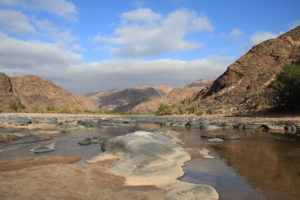Rock stratas of purples, pinks and greys stretch along a 100-mile (161km) course. Yet it comes as something of a shock when you arrive at the canyon, as you have no idea it is there. It drops vertically by 1,800ft (550m) out of a flat arid plateau without any warning, even though at some points it is 17 miles (27km) wide!
According to the San Bushmen the twists and curves were carved by the serpent, Kouteign Kooru, in an attempt to escape capture. However, geologists say it was initially created by a fracture in the earth’s crust 500 million years ago. Erosion and the action of glaciers then further deepened the canyon.
In the base of the canyon only remnants of the great Fish River remain and all you can see from the viewpoints are distant emerald pools. After rains the energetic stream tries to muster up enough energy to be called a river. It is down here in the canyon floor here that hikers pit themselves against the elements on one Southern Africa’s most famous and popular hiking trails. The hike covers a distance of 54 miles (86km) over 5 days in the base of the canyon, with absolutely no facilities whatsoever. You have only what you carry on your back and whatever water you can find in semi-permanent pools. Because of its arduous nature, the National Park’s office insists on a certificate of fitness before you are allowed to commence the walk. The reason for never turning back, is that your hike ends at Ai-Ais Hot Springs, where you can dip your sore feet and weary body in therapeutic hot water.
AIS-AIS HOT SPRINGS
Ai-Ais is the Nama word meaning ‘burning water’ and you can expect water temperatures of around 60ºC. The sulphurous springs originate deep underground and are rich in minerals which are reputedly beneficial for those with rheumatic or nervous disorders. Ais-Ais falls within the Fish River Canyon conservation area and the hot springs are a public facility. It is perhaps for this reason that they are not in the least exotic apart from a few alluring palm trees. The spring-water swimming pools are rather unimaginative, but there is an indoors spa with jacuzzi and spa bath to help takes the knots out of tired muscles.
The landscape is desolate, dusty and rock strewn, but the hills and chasms are enticing. These are wonderful to explore, especially on a horse in the cooler early morning or late afternoon. This barren area is just too hot during the summer so the resort is closed from November to mid March.
ANIMALS & BIRDS
Opportunities for game watching is limited but springbok and steenbok are sometimes seen on the plains at Hobas. Klipspringer and troops of Chacma baboons are happy on rocky slopes and mountain zebra favour the rugged ravines but are rarely seen. Some kudu inhabit the densely vegetated lower reaches of the canyon. The riverine bush of the canyon attracts an interesting variety of colourful birds and raptors such as rock kestrals and lanner falcons ride the thermals.
SEASONS
Summer: November to April are the hottest months with average mid-summer temperatures ranging between 97°F and 100°F (36°C-38°C) and reaching in excess of 104°F (40°C) by midday in the canyon.
Winter: May to September are cooler but you can still expect daytime sunshine and pleasantly warm to hot temperatures. At night it can get very cold with a mid-winter July minimum of 44.5°F (7°C) or less, especially in the canyon.
Rainy Season: The annual rainfall is highly variable and erratic and varies between 2 inches (50mm) and 4 inches (10mm) per year.
FISH RIVER CANYON SPECIALITIES
· 54 miles (86km) Fish River Canyon hike
· Magnificent views of the canyon
· Exquisite photographic opportunities
· Floating in therapeutic hot springs
· Unique desert environment
FACTS
Ais Ais Hot Springs is closed from November to mid-March as it is just too hot.
This is not a malarial area.

